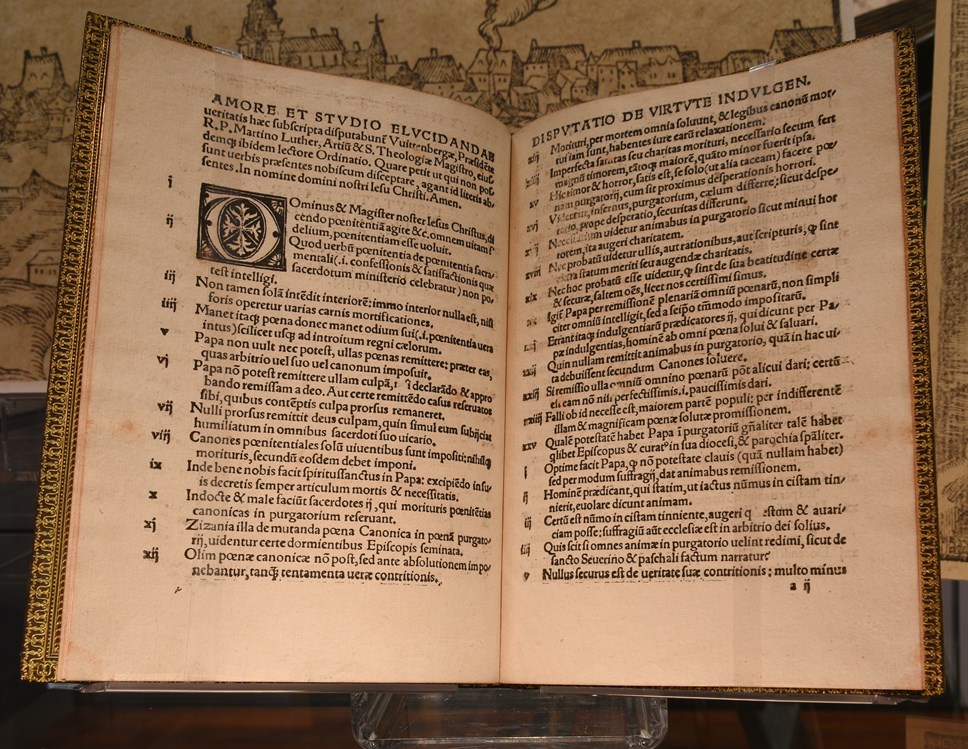
RARE REFORMATION DOCUMENTS ON SHOW AT NATIONAL LIBRARY
500th anniversary of the beginning of Protestant Reformation marked by display of key historic documents
A rare copy of one of the most important documents in European history is on show at the National Library of Scotland in a new display that explains the beginnings of the Protestant Reformation.
In October 1517, an obscure monk named Martin Luther nailed a poster to a church door in Wittenberg in Germany questioning some of the practices in the Catholic Church. His '95 theses', as the document is known, would go on to split the Christian world and produce ramifications that live on to the present day.
Only a few copies of the very first printing of the 95 theses have survived. The Library shows one of these along with other original key texts of the Reformation in the new display entitled, 'The Reformation: What was it all about?
The 95 theses were produced at a time of concern about corruption within the Catholic Church. Luther’s target was the sale of indulgences through which people could pay money to the church and receive exemption from punishment for certain sins. It was a form of insurance against temporal punishment in purgatory, promoted by the Church but attacked by critics.
The 95 theses were intended to stimulate academic debate and were written in Latin. The document begins: “Out of love for the truth and from desire to elucidate it, the Reverend Father Martin Luther … intends to defend the following statements and to dispute on them.”
The academic debate Luther sought never happened as other people took up the cause and used the printing press – the new media of the day – to challenge the Church’s authority. Within two weeks, copies of the 95 theses had spread throughout Germany and, within two months, throughout Europe. In 1518, they were translated into German, further widening the audience for these iconoclastic ideas that were to lead to the birth of the Protestant Church.
For the next three years, Luther defended his actions but in 1521 he was finally excommunicated. The display also contains an extremely rare copy of the papal bull that severed Luther’s ties with the Catholic Church.
Visitors can also see documents that tell of his interrogations by church and imperial authorities, his major Reformation tracts and an early edition of the Bible in Luther’s German. These documents are augmented by contemporary woodcut portraits of the main players and venues as well as scenes from daily life.
Rare books curator Anette Hagan who has developed the display said: “We are marking the 500th anniversary of the beginning of the Reformation by putting on display some of the key documents that tell the story of what happened.
The spread of the Reformation was unthinkable without the printing press. Luther and his followers, as well as their opponents, were quick to harness what was the social media of their day. By 1525, some 287 tracts by Luther had been printed running to some two million copies. Luther emerged as the bestselling author in the Holy Roman Empire. This is a story that changed history.”
The Reformation: What was it all about?' is on at the National Library of Scotland, George IV Bridge, Edinburgh from 19 October to 10 December 2017. Entry is free.
Ends
Contact Information
Notes to editors
The National Library of Scotland
The National Library of Scotland is a major European research library and one of the world’s leading centres for the study of Scotland and the Scots - an information treasure trove for Scotland’s knowledge, history and culture. The Library’s collections are of world-class importance. Key areas include digital material, rare books, manuscripts, maps, music, moving images, official publications, business information, science and technology, and modern and foreign collections. The Library holds more than 26 million physical items dating back over 1000 years in addition to a growing library of e-books, e-journals and other digital material. The collection includes over four million books, eight million manuscripts, two million maps and over 45,000 films and videos. Every week the Library collects around 3,000 new items. Most of these are received free of charge in terms of Legal Deposit legislation. www.nls.uk / @natlibscot /facebook
